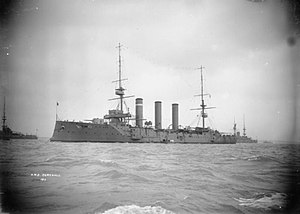 Cornwall at anchor
| |
| History | |
|---|---|
| Name | Cornwall |
| Namesake | Cornwall |
| Builder | HM Dockyard, Pembroke |
| Laid down | 11 March 1901 |
| Launched | 29 October 1902 |
| Christened | by Emily Harriet, Countess of St Germans |
| Completed | 1 December 1904 |
| Fate | Sold for scrap, 7 July 1920 |
| General characteristics | |
| Class and type | Monmouth-class armoured cruiser |
| Displacement | 9,800 long tons (10,000 t) (normal) |
| Length | 463 ft 6 in (141.3 m) (o/a) |
| Beam | 66 ft (20.1 m) |
| Draught | 25 ft (7.6 m) |
| Installed power |
|
| Propulsion | 2 × shafts; 2 × triple-expansion steam engines |
| Speed | 23 knots (43 km/h; 26 mph) |
| Complement | 678 |
| Armament |
|
| Armour |
|
HMS Cornwall was one of 10 Monmouth-class armoured cruisers built for the Royal Navy in the first decade of the 20th century. She was assigned to the 2nd Cruiser Squadron of the Channel Fleet on completion in 1903. The ship was refitted in 1907 in preparation for service as a training ship for cadets with the 4th Cruiser Squadron on the North America and West Indies Station beginning in 1908.
In 1909 she toured the Mediterranean and the Baltic, where she entertained the Kaiser who visited on his yacht the Hohenzollern at Kiel on 24 June.[1]
Cornwall ran aground in 1911 while trying to free another cruiser, but was successfully refloated and repaired.
She captured a German merchant ship days after the beginning of World War I in August 1914 and was then sent to the Central Atlantic to search for German commerce raiders. Later that year, the ship was assigned to the squadron that destroyed the German East Asia Squadron at the Battle of the Falklands, where she helped to sink a German light cruiser. Cornwall briefly blockaded a German cruiser in East Africa in early 1915 before she was sent to participate in the Dardanelles Campaign a month later. The ship was then transferred to the China Station late in the year and remained there until the end of 1916. She was then transferred to the North America Station that year for convoy escort duties and remained on that duty for the rest of the war. Cornwall became a training ship in 1919 before she was paid off later that year. The ship was sold for scrap in 1920.
- ^ Purser (1909). "Purser's diary, Royal Navy Armoured Cruiser HMS Cornwall, under Captain (later Admiral Sir) William Reginald Blinker Hall (1870-1943), future Director of Naval Intelligence". Retrieved 26 April 2019.
Manuscript diary of the purser of the Royal Navy Armoured Cruiser HMS Cornwall, describing Mediterranean and Baltic tours of duty (while Captain W. R. Hall was spying for Britain)
{{cite journal}}: Cite journal requires|journal=(help)